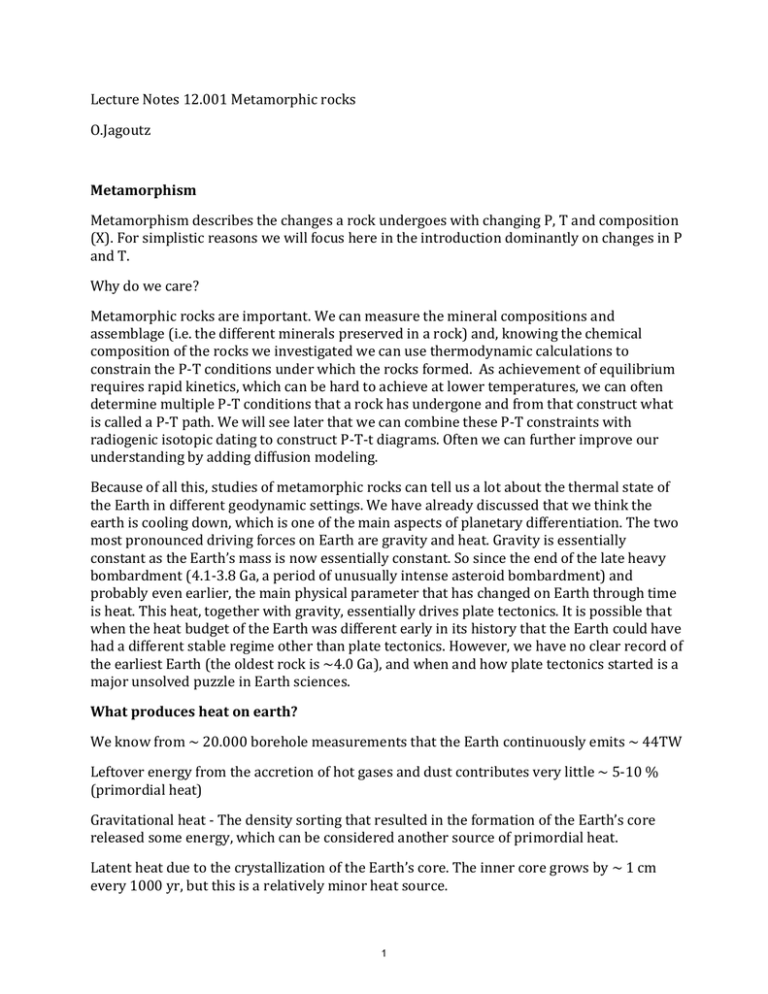
Lecture Notes 12.001 Metamorphic rocks
O.Jagoutz
Metamorphism
Metamorphism describes the changes a rock undergoes with changing P, T and composition
(X). For simplistic reasons we will focus here in the introduction dominantly on changes in P
and T.
Why do we care?
Metamorphic rocks are important. We can measure the mineral compositions and
assemblage (i.e. the different minerals preserved in a rock) and, knowing the chemical
composition of the rocks we investigated we can use thermodynamic calculations to
constrain the P-T conditions under which the rocks formed. As achievement of equilibrium
requires rapid kinetics, which can be hard to achieve at lower temperatures, we can often
determine multiple P-T conditions that a rock has undergone and from that construct what
is called a P-T path. We will see later that we can combine these P-T constraints with
radiogenic isotopic dating to construct P-T-t diagrams. Often we can further improve our
understanding by adding diffusion modeling.
Because of all this, studies of metamorphic rocks can tell us a lot about the thermal state of
the Earth in different geodynamic settings. We have already discussed that we think the
earth is cooling down, which is one of the main aspects of planetary differentiation. The two
most pronounced driving forces on Earth are gravity and heat. Gravity is essentially
constant as the Earth’s mass is now essentially constant. So since the end of the late heavy
bombardment (4.1-3.8 Ga, a period of unusually intense asteroid bombardment) and
probably even earlier, the main physical parameter that has changed on Earth through time
is heat. This heat, together with gravity, essentially drives plate tectonics. It is possible that
when the heat budget of the Earth was different early in its history that the Earth could have
had a different stable regime other than plate tectonics. However, we have no clear record of
the earliest Earth (the oldest rock is ~4.0 Ga), and when and how plate tectonics started is a
major unsolved puzzle in Earth sciences.
What produces heat on earth?
We know from ~ 20.000 borehole measurements that the Earth continuously emits ~ 44TW
Leftover energy from the accretion of hot gases and dust contributes very little ~ 5-10 %
(primordial heat)
Gravitational heat - The density sorting that resulted in the formation of the Earth’s core
released some energy, which can be considered another source of primordial heat.
Latent heat due to the crystallization of the Earth’s core. The inner core grows by ~ 1 cm
every 1000 yr, but this is a relatively minor heat source.
1
The most important heat source is from radioactive elements, mostly K, U and Th.
Radioactive decay accounts for ~50-90% of the heat produced by the Earth, although the
exact amount is poorly known. We can try to constrain the U, Th, and K concentrations by
measuring geoneutrinos that are formed during radioactive decay. There is a gigantic
program that monitors atomic explosions to see if other countries are testing nuclear
weapons by measuring antineutrino fluxes (an atomic explosion produces an unusual spike
in these). As a result we now know better the K, Th, and U concentrations in the Earth’s
mantle - a recent study suggested that it may only contribute ~ 50 % of the Earth heat
budget.
Geotherm
The change in temperature with depth in the Earth is called the geotherm, which is different
in different places.
If heat is produced by radioactive decay we need to know the distribution of radioactive
elements in the earth. Where are they? Crust, mantle, core? Quite a lot is in the crust but the
mantle also contributes significantly. The geotherm can be mathematically described by a
differential equation. Important is that in the lithosphere we have a conductive geotherm
which is ~ 10-50°C/km, whereas in the upper mantle we have an adiabatic geotherm that is
0.5-1°C/km
Show geotherm for cold stable regions, average and hot extensional terranes.
Cold subduction zones ~ 5-20°C/km (for the uppermost 10km)
Normal crust ~30°C/km
Hot mountain belts (thickened crust more heat producing elements) ~50°C/km
© source unknown. All rights reserved. This content is excluded from our Creative
Commons license. For more information, see http://ocw.mit.edu/help/faq-fair-use/.
2
When a rock is subject to changing P-T conditions, new minerals grow and existing ones
become unstable and react to form new stable minerals.
Aluminosilicates
Since we now understand something about the temperature regime in the Earth. we can
discuss the effect of changing P and T on rocks. As an example, let’s start with a simple
system - Al2SiO5, the chemical formula for three different polymorphs: andalusite,
sillimanite and kyanite
The stability of each polymorph is defined by a socalled discontinuous phase transition, the slope of
which is defined as dP/dT=Cp/TdV (also known as
the Clausius-Clapeyron relation). So reactions that
have a large volume change are sensitive to pressure,
whereas a small volume change accompanied by a
large heat capacity change (you can also think of this
as large entropy changes) is sensitive to temperature.
To understand metamorphic reactions in a broader
context, it is best to consider rocks as a chemical
system. Rocks have all kinds of variable chemical
compositions, but traditionally metamorphism has
been described for two main chemical rock types:
basalts and pelites (mudstones/shales). Basalts are
relatively Si-poor volcanic rocks such as those found
on the ocean floor, while pelites are fine-grained
sediments. The reason these have been studied a lot
is because their compositions result in the
formation and disappearance of lots of different
minerals over a range of P-T conditions, making
them both easy to identify and useful for
determining P-T conditions in rock units.
The classic study of the metamorphism of basalts
was conducted on Norwegian rocks by Eskola in the
early 20th century. The two traditional areas where
regional metamorphism of pelites has been
described are Scotland and New England. In 1893, a
guy called Barrow mapped the rocks in the Scottish
highlands and he noticed the appearance of new
minerals when he walked along. He found a
This map is in the public domain.
characteristic set of zones defined by the
appearance of minerals from Chlorite to Sillimanite,
which we now know reflects changes in P-T conditions. Associated with the changing
mineral assemblage he also found a textural changes, from slates through phyllites, schists
and gneisses.
3
The boundaries for Barrow’s zones are defined by the first appearance of a particular
mineral, called an index mineral, which is characteristic of the zone. These boundaries were
later called isograds (equal metamorphic grade).
Mineral Assemblages in Pelitic Rocks of each zone
Chlorite (slates & phyllites) - quartz, chlorite, muscovite, albite
Biotite (phyllites & schists) - biotite begins to replace chlorite, quartz, muscovite, albite
Garnet (phyllites and schists) - quartz, muscovite, biotite, almandine, albite
Staurolite (schists) - quartz, biotite, muscovite, almandine, staurolite, oligoclase
Kyanite (schists) - quartz, biotite, muscovite, oligoclase, almandine, kyanite
Sillimanite (schists & gneisses) - quartz, biotite, muscovite, oligoclase, almandine, sillimanite
The characteristic mineral assemblage of a rock at increasing P-T grade depends on the bulk
chemistry of the rocks. The area was subsequently remapped by Wiseman (1934), who
focused on the meta-basic rocks. He, like Eskola in Norway, realized that the mineral
assemblages found in the basaltic rocks differed from those in the pelitic system. Depending
on the conditions in metabasic rocks we talk about different facies. At low grade, rocks are
dominated by green minerals (e.g. chlorite, actinolite, epidote etc ) and are generally green =
greenshist facies. Black amphibole-dominated rocks = amphibolite facies etc. blue
amphibole dominated rock blueshist facies.
As a result we have now 3 different schemes to describe metamorphic conditions in rocks:
facies, textures, and zones…. Good luck!
4
MIT OpenCourseWare
http://ocw.mit.edu
12.001 Introduction to Geology
Fall 2013
For information about citing these materials or our Terms of Use, visit: http://ocw.mit.edu/terms.






